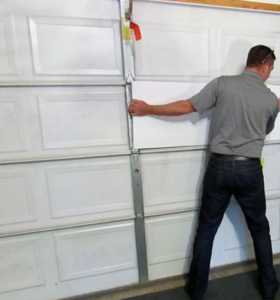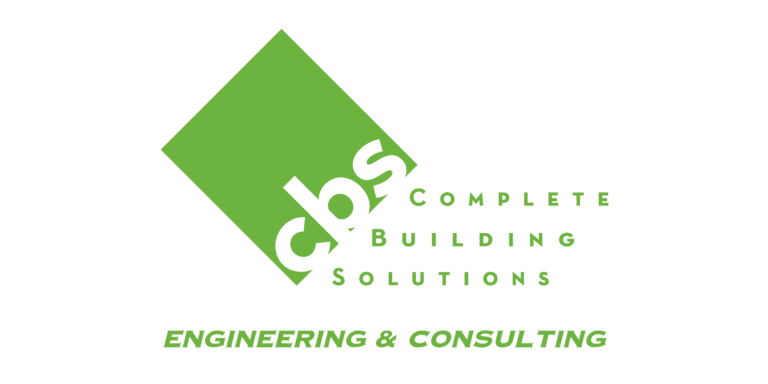If you live in the Midwest, especially Minnesota, you’re likely familiar with the impact of hail. In 2022, State Farm Insurance reported that Minnesota topped the nation in hail damage costs, totaling around $799 million.
That’s a staggering amount of damage.
So, what exactly is hail, and how does it impact homeowners and property owners? How can you tell if your property has hail damage and whether your insurance will cover it?
Thousands are seeking these answers. Keep reading to find out more.
What is Hail?
Hail is essentially chunks of ice that fall from the sky during a storm. The size of the hail varies depending upon the size of the storm or rather the updraft generated by the storm. Commonly, hail size is depicted by comparing it to an object. For instance, it’s common to see pea size or nickel size hail. Golf ball size hail is considered quite large and baseball size hail is rare.
The size of the hail will determine how much damage is done to buildings and automobiles. Golf ball size hail can definitely do some damage especially to your roof, siding and windows.
How is Hail Formed?
Thunderstorms with certain conditions can create the perfect recipe for hail. These conditions are a storm with intense updrafts, high liquid-water content, great vertical extent, large water droplets and when the majority of the cloud layer is below freezing (32 degrees F).
When you get these conditions, it’s extremely likely that hail will form. Raindrops from the storm will be carried upward (updraft) and then freeze when they reach extremely cold temperatures. Small hailstones are formed and they grow by colliding with liquid water drops that essentially freeze to the surface of the existing hailstone. Three factors that help to dictate the size of the hail are: high elevation, low freezing zones and wind shear.
Hail will start falling when the updraft can no longer carry the weight of the hailstone; either the updraft weakens or the hailstone becomes too large.
What is the Biggest Size Hail can get?
The National Severe Storms Laboratory (NSSL) provides us guidelines on how hail size is classified. See their hail size guideline below.
- Pea = 1/4 inch diameter
- Mothball = 1/2 inch diameter
- Penny = 3/4 inch diameter
- Nickel = 7/8 inch
- Quarter = 1 inch — hail quarter size or larger is considered severe
- Ping-Pong Ball = 1 1/2 inch
- Golf Ball = 1 3/4 inches
- Tennis Ball = 2 1/2 inches
- Baseball = 2 3/4 inches
- Tea cup = 3 inches
- Softball = 4 inches
- Grapefruit = 4 1/2 inches
According to the NSSL, the largest ever recorded hail was in Vivian, South Dakota in 2010. The hail measured was 8 inches in diameter and weighed nearly 2 pounds.
WOW! Can you imagine the damage?
It’s more common to have smaller hail, under a golf ball size. However, golf ball size hail is still considered quite large and can do some serious damage to homes and buildings.
Freezing Rain vs. Hail-
If you live in an area where hailstorms are rare, you might not easily distinguish between hail and freezing rain.
Freezing rain is liquid precipitation that turns to ice upon contact with surfaces like roofs, power lines, or roads.
In contrast, hail is actually frozen “ice balls” that can cause significant damage when they strike objects, such as roofs and cars, especially if they are large.
Now, let’s delve into the problems that hail can cause: hail damage.
What is Hail Damage?
Hail damage most commonly affects roofs, siding, windows and automobiles. Since we are a structural engineering firm, we will be focusing on the damages hail does to homes and other building structures.
So, what exactly is it?
Well, it’s when hail actually damages your property. Yes, it can be an eyesore to have denting from hail, but the damage can be much more sinister than that. Denting from hail can allow for water intrusion in your home.
For example, if your shingles are damaged, it can allow for rainwater to find its way into your home causing leaks.
Water leaking into the home can degrade building components leading to structural damage over time and potentially even cause mold.
So, what should you look for?
While it’s always best to have a professional inspect your roof, here are some key signs they will likely check for:
Signs of Hail Damage-
Wood shakes/clay/concrete roofing materials:
Cracking and shattering of these types of roofing material can make the roof vulnerable to water. If water moves under the roofing materials, leaks occur causing building material damage and mold.
Asphalt shingles:
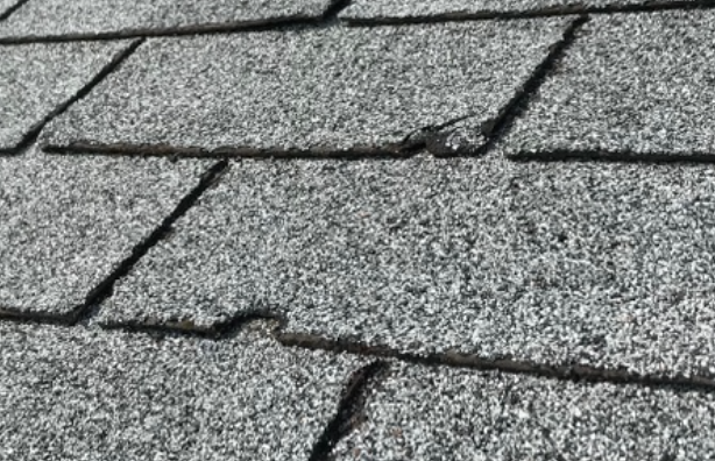
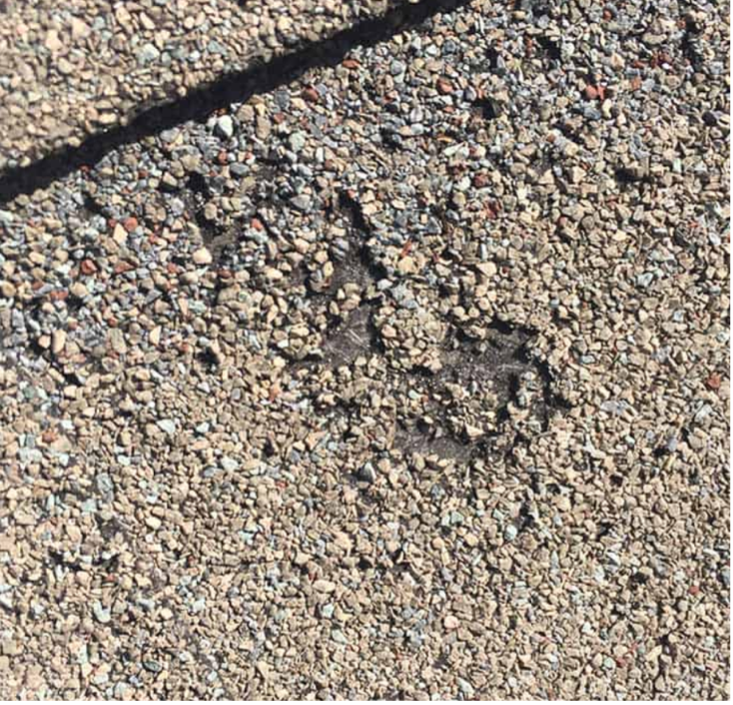
Professionals will look for punctures, tears, fractures, and displacement of granules. Displacement of granules is when the asphalt granules essentially get knocked off the shingle by hail. This is harmful because it exposes underlying shingle to the sun’s UV light which leads to rapid deterioration. Your roof’s life could be cut in half among other issues such as cracking, blistering, algae formation and water leaks.
Vinyl Siding: Damage to vinyl siding could show up as denting, holes, cracking or chipping. Some damage may be more obvious than others. These issues should be addressed immediately to prevent water from seeping behind the siding and causing structural damage.
Steel siding: If damage is present on steel siding it would typically appear as denting. Chipped paint could be present as well.
Windows: Window damage is quite obvious. Cracked glass or denting around the windows are the major indicators.
What is Hail Damage on a Roof?
We talked a little bit about the various types of hail damage above. Since hail damage on roofs is a hot topic, let’s dig deeper.
Hail damage on a roof can manifest in several ways, each potentially compromising the integrity and lifespan of your roofing system.
Hailstones, which vary in size from small pellets to golf balls or larger, can create significant issues when they strike a roof. The impact from these stones can cause dents and cracks in roofing materials, such as asphalt shingles, metal panels, or tiles.
For asphalt shingles, hail damage often appears as dark spots or bruises where the granules have been knocked off, exposing the underlying asphalt.
Over time, this loss of granules can accelerate the deterioration of the shingles, making them less effective at protecting the underlying layers of the roof. Everything really comes down to protecting a home from the elements, the biggest problem being water. If water is allowed to reach the building components, structural and mold issues can occur.
In addition to the visible damage on shingles, hail can also cause problems with other roofing components. For instance, metal roofing can suffer from denting and deformation, which may affect its ability to shed water effectively. This can lead to leaks and further structural damage if not addressed promptly.
Tiles and slate roofs, though generally more resistant, can still be cracked or broken by severe hail, compromising their protective function and potentially leading to water intrusion.
To assess hail damage, it’s often necessary to conduct a thorough inspection of the roof, preferably by a professional who can identify both obvious and subtle signs of impact. This inspection can help determine the extent of the damage and the appropriate course of action for repairs or replacement. Prompt attention to hail damage is crucial to prevent minor issues from escalating into significant problems that could affect the safety and functionality of your home.
Note- If your claim was denied, we may be able to help. Read on to find out more.
Get a free quote on your project!
Ready to start your project? Reach out to Complete Building solutions and get a quote absolutely free.
Can Hail Damage Solar Panels?
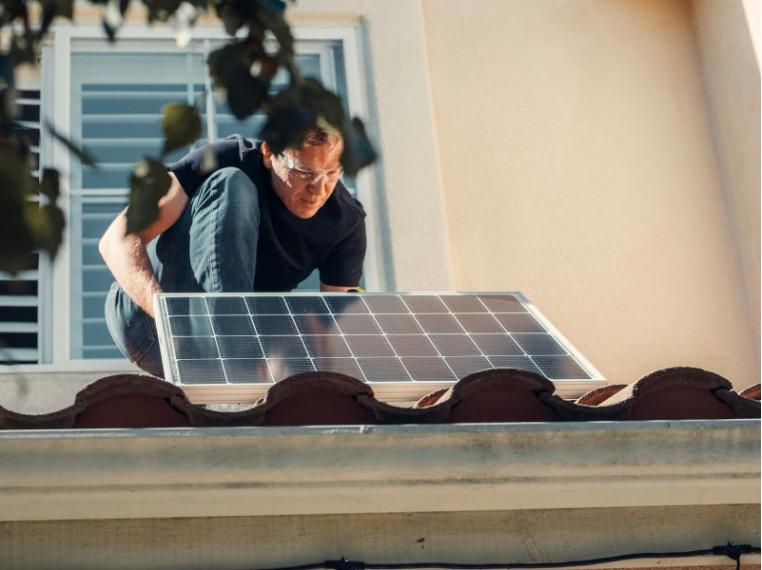
Hail can cause damage to solar panels, which are designed to capture sunlight and turn it into electricity. Solar panels are built to be tough and withstand many weather conditions, but very large hailstones can still hurt them. When hailstones hit the panels, they might create cracks or dents on the surface. This damage can make the panels less efficient at gathering sunlight, which means they won’t produce as much electricity as before.
In addition to making the panels less effective, hail damage can also be expensive to fix. Most solar panels come with warranties that might cover damage from severe weather, but it’s important to check what is included. If you live in an area where big hail storms are common, you might want to look into extra protection or insurance for your solar panels.
To check if hail has damaged your solar panels, follow these steps (note- climbing on roofs is dangerous and it’s best if you hire a professional):
- Visual Inspection: Start with a careful visual inspection of the panels. Look for any noticeable cracks, dents, or chips on the surface of the panels. Pay close attention to the area where the hail would have hit, especially if there are signs of impact. You might also see cracks in the protective glass covering the panels.
- Check for Performance Issues: Monitor the performance of your solar panels. If you notice a significant drop in energy production or if your system isn’t producing as much electricity as it usually does, it could be a sign of damage. Check the readings on your solar inverter or monitoring system for any unusual drops in output.
- Look for Physical Debris: Examine the area around your solar panels for any debris from the hailstorm, such as broken pieces of glass or parts of the panels. This can indicate that the hail may have caused some damage.
- Inspect for Internal Issues: Hire a technician to carefully inspect the panels’ connections and wiring. Hail damage could sometimes affect these components.
- Professional Assessment: If you’re unsure about the condition of your panels or if you notice any signs of damage, it’s a good idea to contact a professional solar technician. They can perform a thorough inspection and determine if repairs or replacements are needed.
Checking your solar panels after a hailstorm can help ensure they continue to operate efficiently and that any damage is addressed promptly.
The Hidden Peril of Hail Damage: Water Intrusion-
Large hail creates obvious physical damage to roofs, siding and windows. And…it’s ugly.
But, beyond aesthetics there is one lurking threat that trumps them all. Can you guess it?
Water intrusion.
Water is enemy #1 when it comes to homes. Over time, it creates wood rot leading to structural integrity issues. Rotten trusses or support beams are not something to play with.
On top of this, it’s a HUGE health hazard as mold and mildew can be generated.
Here are some of the ways hail damage can make your home vulnerable to water intrusion:
- Granule Loss: On asphalt shingles, hail impact often dislodges the protective granules that coat the surface. These granules protect the underlying asphalt from UV rays and weathering. When they are knocked off, the exposed asphalt can deteriorate more quickly, leading to cracks and leaks. Over time, the loss of granules compromises the shingle’s waterproofing abilities, making it easier for water to seep through.
- Cracking and Pitting: Hailstones can create cracks, pits, or holes in roofing materials. Even minor cracks can allow water to enter and infiltrate the roof layers. Once water penetrates the roofing system, it can travel through the layers, potentially causing leaks inside the home. For materials like tiles or slate, hail can cause significant cracks or breakage, which directly expose the roof deck and underlayment to water intrusion.
- Dents and Deformation: Metal roofs can be dented or deformed by hail. While these dents might not always lead to immediate leaks, they can disrupt the roof’s ability to channel water properly. Over time, dents can lead to structural issues or create areas where water collects, increasing the risk of leaks and damage to the roof’s seams and joints. If gutters and downspouts are damaged, water may actually pool around your foundation leading to water in the basement.
- Compromised Flashing: Hail impacts can damage or dislodge flashing, which is the material used to seal joints and transitions on a roof, such as around chimneys, vents, and skylights. Damaged flashing can allow water to penetrate these vulnerable areas, leading to leaks and water damage inside the home.
- Underlayment Damage: The underlayment, which is the layer of material beneath the shingles or roofing tiles, provides additional protection against water infiltration. Hail can damage this layer, compromising its effectiveness. If the underlayment is damaged, water can more easily penetrate through to the roof deck and eventually into the living spaces below.
- Water Accumulation: In cases where hail causes a roof to become uneven or damaged, water may pool or accumulate in certain areas rather than draining away properly. This standing water can increase the likelihood of leaks and contribute to the deterioration of the roof structure over time.
Effective repair and maintenance are crucial to address hail damage promptly. If you suspect hail damage, it’s important to have a professional roof inspection to identify any compromised areas and make necessary repairs.
Remember, your homeowners insurance policy should cover this.
Addressing these issues early can help prevent more serious water damage and preserve the integrity of your roofing system.
What is Hail Damage Covered Under?
Minnesota Statute Section 65A.01 mandates that homeowners’ insurance companies provide coverage for hail damage resulting from storms. However, this doesn’t guarantee a smooth process, as insurers may not always be eager or straightforward in handling claims.
To help you navigate the process effectively, here are some tips for securing the coverage you’re entitled to.
- Review Your Policy Document: Your homeowners insurance policy document is the primary source for understanding coverage details. Look for sections titled “Coverage” or “Policy Provisions,” where you will find specifics about what is covered, including hail damage. Key areas to check are:
- Dwelling Coverage: This section details coverage for structural damage, including hail damage to the roof, siding, and other exterior parts of your home. NOTE: Be sure to know the specifics. What exactly is hail damage to the roof? Does it include granule damage to shingles? Oftentimes, it does not. If your shingles have granule damage, it can actually cut your roof life in half! This is a big deal.
- Personal Property Coverage: This part explains the coverage for damage to belongings inside the home caused by incidents like hail-induced water intrusion.
- Exclusions and Limitations: Review this section to understand any limitations or exclusions related to hail damage or water damage. Again, do NOT make assumptions. Insurance policy’s “change” all the time.
- Check Endorsements and Riders: Some policies include endorsements or riders that modify standard coverage. Look for any additional coverage options you may have added, such as those for specific types of damage or higher coverage limits.
- Contact Your Insurance Agent: Reach out to your insurance agent or broker for personalized assistance. They can provide detailed explanations of your policy’s terms, help you understand coverage limits, and clarify any complex language. They can also confirm if there are any special provisions related to hail damage. It’s obviously preferable that you understand your policy particularly before a hail storm hits.
- Review Your Policy’s Declarations Page: This summary page outlines key coverage limits, deductibles, and other important details. It’s a good starting point for understanding the basics of your policy, including coverage for hail damage.
Note- With Minnesota being the mecca of intense hailstorms, it’s no shock that homeowners struggle to obtain the maximum insurance dollars for a hail claim. Insurance companies are losing money and they’re employing various strategies to mitigate their losses such as changing policy coverage as well as raising deductibles. It’s essential to read the fine print and know your policy’s limitations as well as deductible requirements.
- Consult the Insurance Company’s Website: Many insurance companies offer online resources and FAQs that can help you understand how hail damage is covered. Check for any guides or articles specific to your state or coverage types.
- Understand State-Specific Regulations: Minnesota has specific regulations that may affect homeowners insurance policies. Researching state insurance regulations or consulting with a local insurance advisor can provide insights into any additional protections or requirements related to hail damage.
By following these steps, you can gain a comprehensive understanding of how your insurance policy addresses hail damage, ensuring you are well-informed and prepared in case of a claim.
Key takeaway- Do your research before obtaining a home insurance policy. Read the fine print. Make sure your insurance company covers hail damage with an affordable deductible. Many HOA’s in Minnesota are struggling to even have hail insurance because the deductibles are so incredibly high ie) $25,000 or more. We remember times when deductibles were $1,000-$3,000. With deductibles that high, it makes it tough to even afford to submit a claim. Do your research and select a competitive company. If you’re in the middle of an insurance company battle, read on to see what can be done.
How to File a Hail Damage Insurance Claim?
Here are the steps for filing a hail insurance claim with a roofing contractor taking the lead:
- Hire a Roofing Contractor: Select a reputable roofing contractor with experience in handling insurance claims for hail damage. Ensure they are licensed, bonded, and have positive reviews or recommendations.
- Initial Inspection: The roofing contractor will conduct a thorough inspection of your roof to assess the hail damage. They will document the damage with photos and notes, which will be crucial for your insurance claim.
- Review Insurance Coverage: Provide your roofing contractor with your homeowner’s insurance policy details. They will review the policy to understand coverage limits, deductibles, and specific provisions related to hail damage.
- Discuss Repair Options: Based on the inspection findings, the contractor will discuss repair or replacement options with you. They will provide detailed estimates for the necessary work, including materials and labor costs.
- File the Claim: The roofing contractor will initiate the claim process on your behalf. They will contact your insurance company and provide all necessary documentation, including the inspection report, photos of the damage, and repair estimates.
- Coordinate Adjuster Inspection: The insurance company will likely send an adjuster to inspect the damage. Your roofing contractor should be present during this inspection to ensure all damage is properly documented.
- Negotiate with Insurance Company: If needed, your contractor will negotiate with the insurance company on your behalf to ensure you receive a fair settlement that covers the full extent of the damage and necessary repairs. If the insurance company pushes back, your roofing company may hire a structural engineering firm for supporting evidence.
- Approval and Settlement: Once the claim is approved, review the settlement offer with your roofing contractor. Ensure it covers all agreed-upon repairs or replacement costs. The contractor will proceed with scheduling and completing the repairs.
- Completion of Repairs: Your roofing contractor will oversee the repair or replacement process, ensuring that all work is completed to industry standards and your satisfaction.
- Final Inspection and Payment: After repairs are finished, the contractor will perform a final inspection to verify the work meets expectations. They will then coordinate with the insurance company for final payment or reimbursement of costs.
By involving a qualified roofing contractor from the beginning, you can streamline the insurance claim process, ensure accurate documentation of hail damage, and receive expert guidance throughout the repair or replacement of your roof.
What to do if my Hail Claim is Denied?
If your hail claim gets denied, don’t panic.
Insurance companies won’t just give out money without proof of real hail damage. They’ll send you a report with their assessment and the amount they think you should get, but it might not meet your expectations.
This can leave you feeling like you need to negotiate for the coverage you believe you deserve.
So, what can you do?
First, understand that after you file a claim, the insurance company will send their own inspector to check for damage. Keep in mind, this inspector works for the insurance company, so their report might be biased.
If you or your contractor thinks there’s real hail damage that hasn’t been properly recognized, you can hire an unbiased third party to inspect your property. This is your right.
The best choice for an unbiased opinion is a structural engineering firm. Why? Structural engineering firm’s opinions are highly respected and most times undisputable. The contractor on your case will most likely be the one to hire the engineer.
They can inspect your roof, create a detailed report, and provide a scope of work that is compliant with manufacturer specs and codes. Their assessments are highly respected, come with some serious authority and often used to resolve disputes with insurance companies.
Note- If genuine hail damage exists, it’s crucial that the homeowner receive the dollar amount entitled to them. If insurance funds aren’t available, corners get cut and work is not performed in compliance with applicable building codes. This is unacceptable and is why structural engineers are such a valuable asset when challenging insurance claims.
Our firm is truly unique because we blend over 40 years of hands-on building experience with innovative engineering skills. This rare combination of field knowledge and advanced technical insight sets us apart from any other firm.
Not only do we know when real hail damage exists and is a threat to a building’s structural integrity, we also know how to repair the issue, a rough estimate of what it will cost to fix correctly and how to make sure the work meets all applicable building codes and manufacturers specifications (not all firms have this expertise so be sure to ask questions before hiring a company).
We have dealt with many cases like this before. Please feel free to reach out with questions on your specific hail case. 763-544-3355.

